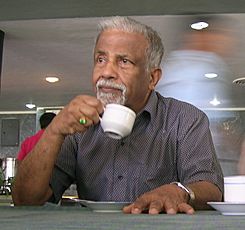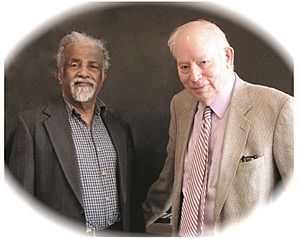E. C. George Sudarshan facts for kids
Quick facts for kids
George Sudarshan
|
|
|---|---|

E. C. G. Sudarshan at TIFR Mumbai in 2009
|
|
| Born | 16 September 1931 Pallom, Travancore, British India
|
| Died | 13 May 2018 (aged 86) |
| Alma mater | CMS College Kottayam Madras Christian College University of Madras University of Rochester |
| Known for | Coherent states Optical equivalence theorem Glauber–Sudarshan representation GKSL equation V-A theory Tachyon Quantum Zeno effect Open quantum system Spin–statistics theorem |
| Spouse(s) |
Lalita Rau
(m. 1954–1990)Bhamathi Gopalakrishnan
(m. 1990) |
| Children | 3 |
| Parents |
|
| Awards |
|
| Scientific career | |
| Fields | Theoretical physics |
| Institutions | University of Texas at Austin Indian Institute of Science Institute of Mathematical Sciences, Chennai Harvard University University of Rochester Tata Institute of Fundamental Research |
| Doctoral advisor | Robert Marshak |
| Doctoral students | Mohammad Aslam Khan Khalil Narasimhaiengar Mukunda |
Ennackal Chandy George Sudarshan (also known as E. C. G. Sudarshan; born September 16, 1931 – died May 13, 2018) was a brilliant Indian American theoretical physicist. He was a professor at the University of Texas. Sudarshan made many important discoveries in physics. These include the Glauber–Sudarshan P representation for light, the V-A theory about how particles interact, and even thinking about particles that travel faster than light, called tachyons. He also helped explain the quantum Zeno effect, where observing a particle can stop it from changing.
Contents
Early Life and Education
George Sudarshan was born in Pallom, a place in British India. He grew up in a Christian family. Later in his life, he became interested in traditional Indian ideas and converted to Hinduism. He married Lalita Rau in 1954, and they had three sons. After they divorced in 1990, he married Bhamathi Gopalakrishnan.
He studied at CMS College Kottayam and then at Madras Christian College, graduating in 1951. He earned his master's degree from the University of Madras in 1952. He worked briefly at the Tata Institute of Fundamental Research (TIFR). Later, he moved to the University of Rochester in New York to study under Robert Marshak. He received his Ph.D. in 1958. After that, he joined Julian Schwinger at Harvard University.
Amazing Discoveries in Physics
Sudarshan made huge contributions to many areas of physics.
- Understanding Forces: With Robert Marshak, he created the V-A theory. This theory explains the weak force, one of the four basic forces in nature. Even famous physicists like Richard Feynman and Murray Gell-Mann later used and spread this idea. Feynman even said that Sudarshan and Marshak were the first to discover it.
- Light and Quantum Optics: Sudarshan also did very important work in quantum optics, which is the study of light using quantum mechanics. He developed a way to describe coherent light (like laser light) called the Glauber–Sudarshan P representation. This representation helps show how classical light waves are related to quantum light. It also predicts special quantum effects that cannot be explained by classical physics.
- Faster-Than-Light Particles: Sudarshan was the first to suggest that tachyons might exist. These are theoretical particles that could travel faster than the speed of light!
- Quantum Zeno Effect: He also worked with Baidyanath Misra to propose the quantum Zeno effect. This strange effect suggests that if you keep observing a quantum system, you can actually stop it from changing.
- Open Quantum Systems: He created a special way to study "open quantum systems." These are quantum systems that interact with their surroundings.
Teaching and Leadership
Sudarshan taught at many famous universities and research centers. These include the Tata Institute of Fundamental Research, the University of Rochester, Syracuse University, and Harvard. From 1969, he was a physics professor at the University of Texas at Austin. He was also a senior professor at the Indian Institute of Science.
For five years in the 1980s, he was the director of the Institute of Mathematical Sciences (IMSc) in Chennai, India. He split his time between India and the USA during this period. He helped turn IMSc into a top research center. He was honored on his 80th birthday in 2011.
Sudarshan was interested in many areas of physics, such as elementary particles, quantum optics, and quantum field theory. He was also deeply interested in Vedanta, which is a school of Hindu philosophy, and often gave talks about it.
Awards and Honors
George Sudarshan received many important awards for his scientific work:
- Dirac Medal of the ICTP in 2010
- Padma Vibhushan in 2007, which is the second highest civilian award from the Government of India
- Majorana Prize in 2006
- TWAS Prize in 1985
- Bose Medal in 1977
- Padma Bhushan in 1976, the third highest civilian award from the Government of India
- C V Raman Award in 1970
See also
 In Spanish: George Sudarshan para niños
In Spanish: George Sudarshan para niños


